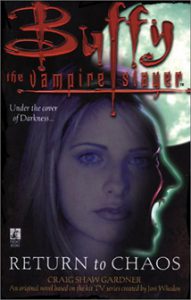In “Return to Chaos” (December 1998), the second novel of the adult “Buffy” series, Craig Shaw Gardner – in his only “Buffy” entry — gets to a lot of concepts before the TV show does. That makes the book an interesting historical curiosity, but it also means it hasn’t aged particularly well.
First off, as with “Child of the Hunt,” “Return to Chaos” is challenging to place on the timeline. It’s set in Season 3 during the week of the Spring Formal, but Xander and Cordelia are still together, as the author hadn’t seen “Lovers Walk” (episode 8) yet. If it had been changed to a “Fall Formal,” the book would’ve worked in continuity. Since Cordy references Angel’s return, it would have to squeeze between “Revelations” (7) and “Lovers Walk,” as with “Child of the Hunt.”
Naomi, a former member of Cordelia’s circle, pops up as a vampire, a precursor to what happens to Harmony. There’s another Cordette named Amanda, too. Oddly, a quick perusal of the “Buffy” credits on IMDB tells me that Cordelia didn’t have friends by these names on the TV series.
Nonetheless, Cordelia stands out in “Return to Chaos” more than anyone else. She’s under a mastery spell cast by a visiting Druid named George (we later find out George himself is under a mastery spell cast by a Druidic vampire named Eric). Gardner does a nice job writing about Cordy’s frustration and horror as, against her will, she tells a girl to go to the alley outside the Bronze, where death awaits. Eric’s mastery spell is a nice tie-in to Drusilla’s ability – used on Kendra in Season 2’s “Becoming, Part 1” – and to that of Dracula, who joins the Buffy-verse in Season 5’s “Buffy vs. Dracula.”
The author anticipates Cordy’s demon database from Season 1 of “Angel” by having Willow and Giles develop a probability program to identify potential supernatural threats in Sunnydale, to give the Scoobies advance warning. It’s more trouble than it’s worth as the computer spits out reams of potentialities (for some reason, the author thinks the potential of “whales with feet” is funny enough to repeat), plus a three-pronged prophecy that’s boring even by prophecy standards.
Gardner anticipates that Oz might want a cure for his lycanthropy, as the Druid visitors suggest they might be able to help him (they can’t, once their uncle dies).
Buffy’s almost-relationship with Ian, the older of the three Druid brothers, is a precursor to post-“Hush” Riley: He’s someone she can date without having to keep secrets; plus, he fights vampires, too.
Gardner delivers solid passages from Joyce’s point of view as she waits for Buffy to come home safely and struggles to have a conversation with her daughter without it turning confrontational. It’s a reminder that as much as we like Buffy’s mom, the TV show doesn’t give us her perspective too often.
“Return to Chaos” has a cranked-out feel; lots of pages are spent going nowhere, as characters just think about the situation. For example, Oz follows Willow and her captor by hanging on to the back of a van, but he doesn’t do anything other than go to Buffy for help (which is logical, just not interesting). Giles is indecisive and ineffective. Willow thinks about the prophecy without coming to any conclusions. Yet we don’t get much of Willow’s perspective when she is a sacrificial captive in the final act.

Eric’s not-at-all-surprising goal – to open the Hellmouth and unleash chaos, thus earning him the thankfulness of the freed demons – calls to mind the wave of demons in the post-Season 5 “Angel” comics, and it touches upon the “end of magic” idea in the “Buffy” Season 8 comics. I appreciate – and Buffy would too — that this villain doesn’t “chat about it all day,” as overwriting about bad guy’s schemes is sometimes a problem in the “Buffy” novels.
A misstep occurs early in the book. Buffy and Ian fight off a football team of vampires, all in uniform. I imagine the disappearance of an entire team would be a worldwide news story, and it would hasten the populace’s discovery of the supernatural world. The concept goes too far and isn’t worth the joke.
Overall, Gardner delivers an uneven but inoffensive 293-page read. His feel for the Buffy-verse is a bit wonky, but the Scoobies are in character, so that makes up for a lot. But with the chronological displacement and the tiptoeing into now-familiar elements without much payoff, it feels like an inconsequential read, too.
Click here for an index of all of John’s “Buffy” and “Angel” reviews.

